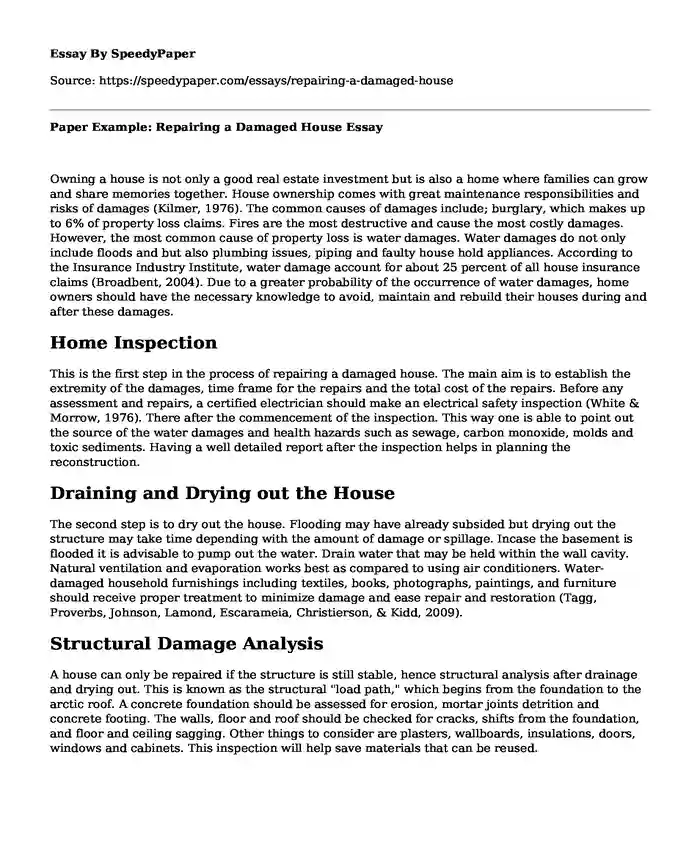
| Type of paper: | Research paper |
| Categories: | Knowledge Engineering Professional development |
| Pages: | 3 |
| Wordcount: | 767 words |
Owning a house is not only a good real estate investment but is also a home where families can grow and share memories together. House ownership comes with great maintenance responsibilities and risks of damages (Kilmer, 1976). The common causes of damages include; burglary, which makes up to 6% of property loss claims. Fires are the most destructive and cause the most costly damages. However, the most common cause of property loss is water damages. Water damages do not only include floods and but also plumbing issues, piping and faulty house hold appliances. According to the Insurance Industry Institute, water damage account for about 25 percent of all house insurance claims (Broadbent, 2004). Due to a greater probability of the occurrence of water damages, home owners should have the necessary knowledge to avoid, maintain and rebuild their houses during and after these damages.
Home Inspection
This is the first step in the process of repairing a damaged house. The main aim is to establish the extremity of the damages, time frame for the repairs and the total cost of the repairs. Before any assessment and repairs, a certified electrician should make an electrical safety inspection (White & Morrow, 1976). There after the commencement of the inspection. This way one is able to point out the source of the water damages and health hazards such as sewage, carbon monoxide, molds and toxic sediments. Having a well detailed report after the inspection helps in planning the reconstruction.
Draining and Drying out the House
The second step is to dry out the house. Flooding may have already subsided but drying out the structure may take time depending with the amount of damage or spillage. Incase the basement is flooded it is advisable to pump out the water. Drain water that may be held within the wall cavity. Natural ventilation and evaporation works best as compared to using air conditioners. Water-damaged household furnishings including textiles, books, photographs, paintings, and furniture should receive proper treatment to minimize damage and ease repair and restoration (Tagg, Proverbs, Johnson, Lamond, Escarameia, Christierson, & Kidd, 2009).
Structural Damage Analysis
A house can only be repaired if the structure is still stable, hence structural analysis after drainage and drying out. This is known as the structural "load path," which begins from the foundation to the arctic roof. A concrete foundation should be assessed for erosion, mortar joints detrition and concrete footing. The walls, floor and roof should be checked for cracks, shifts from the foundation, and floor and ceiling sagging. Other things to consider are plasters, wallboards, insulations, doors, windows and cabinets. This inspection will help save materials that can be reused.
Flood Resistance Construction
The main goal of this form of construction is to ensure the house does not float collapse or move laterally during floods/ excess water. This can be done through; construction of flood walls around the house to avoid water from reaching a house, elevation of the house above possible water level and building strengthened foundation (Procter & Gable, 2010). Construction should be done using flood resistant materials. These are materials classified by FEMA as resilient and can handle specified water exposure without damaging. According to the NFIP, a branch of FEMA, the best resistant materials are rated 4 and 5 (Broadbent, 2004). These are the materials to be used in repairing to avoid future reoccurrence
Summary
Repairing a house requires skills, time, and resources. In the case of a water-damaged house, the owner must first make a home inspection to determine the root cause of the water damage, the extent of the damage, and the approximate cost of repair. Secondly, the structure has to be dried to avoid further detrition of the structure. A structural analysis is done nest to establish the structural strength. Finally, the construction should be flood resistant using flood-resistant materials to avoid reoccurrence
References
Broadbent, C. (2004). Improving the flood resistance of domestic property. Structural Survey, 22(2), 79-83. Retrieved from: https://www.emerald.com/insight/content/doi/10.1108/02630800410538604/full/html
Kilmer, R. (1976). Home remodeling. The design. Service in action; no. 9.922. Retrieved from: https://ccu.marmot.org/GroupedWork/16e4918f-6d74-0cbe-0931-f7283fbf586c/Home%20graphs%20or%20charts%20if%20applicable
Procter, B., & Gable, S. (2010). Resources for your flooded home. Retrieved from: https://mospace.umsystem.edu/xmlui/bitstream/handle/10355/51819/mp0904-2010.pdf?sequence=1
Tagg, A., Proverbs, D., Johnson, M., Lamond, J., Escarameia, M., von Christierson, B., & Kidd, B. (2009). Drying flood-damaged buildings. Retrieved from: http://eprints.hrwallingford.co.uk/331/
White, B. J., & Morrow, A. M. (1976). Home remodeling. Doing the work. Service in action; no. 9.923. Retrieved from: https://ccu.marmot.org/GroupedWork/3bbea9d4-131a-6c4f-deb6-56e2f320b018/
Cite this page
Paper Example: Repairing a Damaged House. (2023, Mar 12). Retrieved from https://speedypaper.com/essays/repairing-a-damaged-house
Request Removal
If you are the original author of this essay and no longer wish to have it published on the SpeedyPaper website, please click below to request its removal:
- Animal Behavior Research in Our Free Essay Example
- Disparities in Education, Essay Example
- Free Essay on Cloud Environment Optimization
- Naturalistic Observation - Essay Sample on Eye Contact
- Sociological Concept of Functionalism
- Essay Sample on Good Governance and Economic Growth
- Professional Values and Goals - Essay Example
Popular categories




